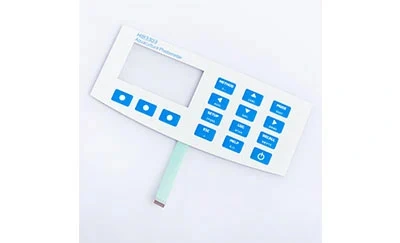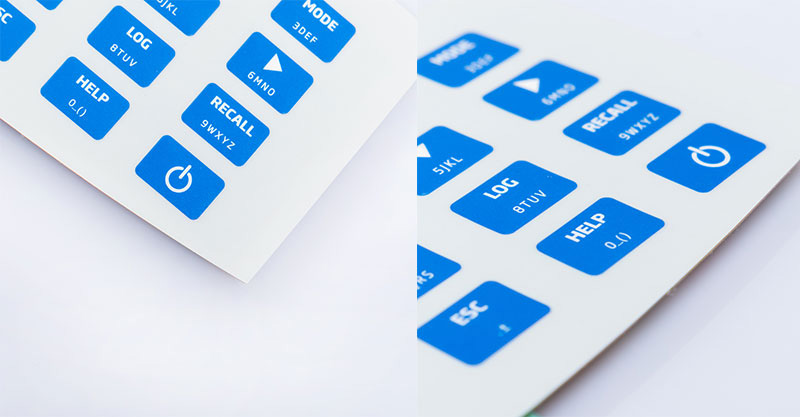
Discover the unbeatable durability of our membrane switches, crafted to redefine reliability and performance in electronic devices.

Membrane switches have revolutionized the way we interact with electronic devices. Their unparalleled durability is not just a claim but a well-engineered reality. From household appliances to advanced medical equipment, the presence of these switches underscores a commitment to longevity and reliability. But what's the magic formula behind their exceptional durability? Let's unveil the secret layers and components that make our membrane switches stand the test of time.
Material Quality: Niceone Tech uses high-grade materials that enhance the lifespan of membrane switches. The choice of materials for the overlay, adhesive, and circuit layers plays a significant role in ensuring durability.
Environmental Resistance: Waterproof flexible membrane switches from Niceone Tech are designed to withstand harsh environmental conditions, including extreme temperatures, humidity, and exposure to chemicals. This makes them ideal for use in industrial and outdoor settings.
Wear and Tear: The switches are engineered to endure frequent use without significant wear and tear. The tactile response and actuation force are optimized to provide a consistent user experience over time.
Sealing and Protection: Niceone Tech incorporates advanced sealing techniques to protect the internal components of the membrane switches from dust, moisture, and other contaminants. This enhances their durability and reliability.
The production process of membrane switches involves precision and technological sophistication. State-of-the-art manufacturing techniques such as laser cutting and digital printing contribute significantly to the durability of the end product.
Design and Engineering
The process begins with the design and engineering phase, where the specific requirements of the membrane switch are outlined. This includes:
Custom Design: Collaborating with clients to understand their needs and creating custom designs that meet their specifications.
Prototyping: Developing prototypes to test the design and functionality before full-scale production
Material Selection
Choosing the right materials is crucial for the performance and durability of membrane switches. This involves:
Overlay Materials: Selecting high-quality polyester or polycarbonate for the top layer, which provides durability and resistance to wear and tear.
Adhesives: Using strong adhesives that ensure the layers of the membrane switch remain securely bonded.
Circuit Layers: Choosing conductive materials like silver or carbon for the circuit layers to ensure reliable electrical performance.
Printing
The next step is printing the graphic overlay and circuit layers. This includes:
Graphic Overlay Printing: Using screen printing or digital printing techniques to create the desired graphics, symbols, and text on the overlay.
Circuit Printing: Printing the conductive traces and contacts on the circuit layers using precision printing methods to ensure accurate and reliable electrical connections.
Lamination
Lamination is the process of assembling the different layers of the membrane switch. This involves:
Layer Alignment: Carefully aligning the overlay, spacer, and circuit layers to ensure proper functionality.
Bonding: Using heat and pressure to bond the layers together, creating a single, cohesive unit.
Die-Cutting
Die-cutting is used to shape the membrane switch and create openings for buttons, LEDs, and other components. This step includes:
Precision Cutting: Employing die-cutting machines to achieve precise shapes and dimensions.
Quality Control: Inspecting the cut pieces to ensure they meet the required specifications.
Assembly
The assembly phase involves integrating additional components and finalizing the membrane switch. This includes:
Adding Components: Incorporating tactile domes, LEDs, and other necessary components.
Final Assembly: Assembling the complete membrane switch and ensuring all parts are securely in place.
Testing and Quality Control
Rigorous testing and quality control measures are essential to ensure the membrane switches meet the highest standards. This involves:
Electrical Testing: Checking the electrical functionality of the switches to ensure they operate correctly.
Durability Testing: Conducting tests to assess the durability and resistance to environmental factors.
Visual Inspection: Inspecting the final product for any defects or inconsistencies.
Packaging and Shipping
The final step is packaging the membrane switches for delivery. This includes:
Protective Packaging: Using appropriate packaging materials to protect the switches during transit.
Labeling and Documentation: Ensuring all products are correctly labeled and accompanied by the necessary documentation.
When it comes to custom membrane switches, customization does not come at the expense of durability. Whether it's tactile membrane switches or LED membrane switch, our membrane switches maintain their robustness. This segment will highlight how custom features are integrated without compromising on the durability factor.
High-Quality Materials: We use premium materials that are both flexible for customization and resilient to wear and tear. This ensures that even with custom designs, the membrane switches can withstand rigorous use and harsh environmental conditions.
Advanced Engineering: Our team of skilled engineers employs cutting-edge technology to incorporate custom features such as tactile feedback, backlighting, and specialized graphics. These features are seamlessly integrated into the membrane switch design, ensuring they do not affect the overall durability.
Rigorous Testing: Every custom membrane switch undergoes stringent testing to ensure it meets our high standards for durability and performance. This includes environmental testing, electrical testing, and mechanical testing to verify that the custom features do not compromise the switch’s robustness.
Precision Manufacturing: Our state-of-the-art manufacturing processes allow for precise customization while maintaining the structural integrity of the membrane switches. This precision ensures that each custom feature is accurately implemented without weakening the switch.
Protective Coatings and Seals: To further enhance durability, we apply protective coatings and seals that safeguard the custom membrane switches from moisture, dust, and other contaminants. This additional layer of protection ensures long-lasting performance, even in challenging environments.
How do membrane switches compare to traditional mechanical switches in terms of durability?
Membrane switches generally offer superior durability compared to traditional mechanical switches due to their sealed construction, which protects against dust, moisture, and other contaminants. They have fewer moving parts, reducing the risk of mechanical failure and wear over time. Additionally, membrane switches are often made from robust materials that can withstand harsh environmental conditions, making them ideal for applications requiring long-term reliability. In contrast, mechanical switches, with their exposed components and higher susceptibility to wear and tear, may require more frequent maintenance and replacement.
Can membrane switches withstand harsh industrial environments?
Yes, membrane switches are well-suited to withstand harsh industrial environments. They are designed with robust materials and sealed construction that protect against dust, moisture, chemicals, and extreme temperatures. This makes them highly durable and reliable for use in demanding settings such as manufacturing plants, outdoor equipment, and medical devices. Additionally, advanced sealing techniques and protective coatings further enhance their resistance to environmental factors, ensuring long-term performance and minimal maintenance in challenging conditions.
What maintenance is required to preserve the durability of a membrane switch?
Regular Cleaning: Gently clean the surface of the membrane switch with a soft, damp cloth to remove dust, dirt, and other contaminants. Avoid using harsh chemicals or abrasive materials that could damage the overlay.
Avoid Excessive Force: Ensure that users do not apply excessive force when pressing the keys. Membrane switches are designed for light to moderate pressure, and excessive force can lead to premature wear.
Environmental Protection: If the membrane switch is used in a particularly harsh environment, consider additional protective measures such as enclosures or covers to shield it from extreme conditions like heavy moisture, direct sunlight, or chemical exposure.
Periodic Inspection: Regularly inspect the membrane switch for signs of wear, damage, or malfunction. Early detection of issues can prevent more significant problems and extend the switch’s lifespan.
Proper Installation: Ensure that the membrane switch is correctly installed according to the manufacturer’s guidelines. Improper installation can lead to misalignment, which may affect functionality and durability.
Avoid Sharp Objects: Prevent the use of sharp objects or tools on the membrane switch surface, as these can puncture or scratch the overlay, compromising its integrity.
The secret behind the durability of our membrane switches is a blend of high-quality materials, advanced manufacturing processes, and continuous innovation. By prioritizing longevity and reliability, we ensure that every touch, press, and interaction is backed by unwavering durability.